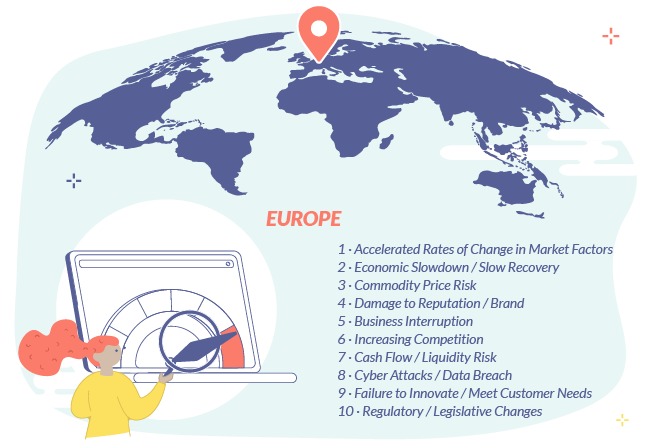
Times of crisis often go hand in hand with business growth. The life cycle of any business is characterised by a succession of stages, where crises usually represent one of its vital phases, becoming a key factor for its growth or disappearance.
It is important to know how to identify some of the red flags that indicate that our business could be facing a crisis. In this post we review the 5 red flags that we should take into account.
Business crisis: what is it and how does it manifest itself?
During the course of a company's business, different events or circumstances can occur that have the potential to impact the business ecosystem and even disrupt its equilibrium state.
A business crisis can refer to a number of situations, such as a profound change, a reduction in the rate of business growth or an economic down cycle. It can manifest itself in many ways: in the form of a financial crisis, a personnel crisis, a technology crisis or even a bad business reputation. However, not all crises develop in the same way. There are different ways in which crises manifest themselves:
1.- Anticipated: this is an internal and premeditated crisis under a growth approach, e.g. the development of a new strategy. The imbalance experienced in the company is low or moderate.
2.- Reactive: this is caused by an unforeseen and unintended external situation that occurs in the business environment. An example could be the entry of a new competitor. The imbalance can range from moderate to high.
3.- Disruptive: this is an extraordinary event or phenomenon that forces an immediate reaction, e.g. a natural phenomenon or a global pandemic such as COVID-19. The imbalance can be high or very high.
Factors that can cause a business crisis with serious consequences
There are different causes that can unbalance a company's activity and complicate its management. Aon's latest biannual Global Risk Management Survey ranks the top ten global risks that threaten businesses. Explore the top 10 in full:

The speed of change and the economic slowdown are the two main risks in Europe, partly due to the consequences of COVID-19 and the forecast of a future economic downturn.
Warning signs
In the previous section we looked at some of the factors that can lead to a crisis in a company. The following are the main signs that can help us to identify when the company may be at risk:
1.- Long-term financial incapacity
Companies that do not generate sufficient cash flows to make payments on their obligations are at risk of long-term financial problems. This can lead to a serious debt problem that can undermine a large part of the company's profits. If the company finds itself in this situation, it must deal with it in various ways, for example by selling assets, merging with other companies or negotiating with banks and suppliers.
2.- Seasonality and decline in demand
It is natural for companies to face seasonality in their demand, which may be characterised by periods of increasing or decreasing demand. Even so, it is essential to establish risk levels that alert us that the stability of our business may be compromised.
In the event of an alarming drop in demand, we must analyse the situation, identify the factors that have caused it and respond with strategic actions to avoid the associated damage.
3.- Loss of competitiveness
Loss of competitiveness is a long-term threat to companies. When a company loses its competitive ability, it loses the ability to do things better than its competitors and, consequently, its competitive advantage.
It is essential that companies regularly monitor their ability to compete and review their positioning strategy. Optimising work processes, reducing costs, focusing efforts on customer satisfaction or developing new products or services are key factors in maintaining competitive advantage.
4.- Loss of bargaining power with suppliers
Bargaining power with suppliers is one of the main strengths of a company. As this power is lost, the pressure that suppliers can exert on the company increases, posing a major threat to business continuity.
To prevent the supplier from having too much influence, it is necessary to work with multiple suppliers. Another popular practice is often backward vertical integration: through this process an organisation acquires its suppliers, reducing volatilities in the supply chain.
5.- Low level of technological implementation
It has been demonstrated that those companies that are at the forefront of technological implementation are more productive, efficient and competitive.
The current competitive market forces constant improvements and changes in which it is necessary to invest.
All these signs are indicative of serious business problems that may be interrelated. For example, resistance to incorporating technological innovations to digitise processes can lead to a progressive loss of competitive capability and, in the long run, demand for products or services can plummet to such low levels that the business becomes unprofitable.
For the diagnosis to be complete, at least the following areas must be analysed: Organisation. Economic-financial. Marketing and commercial. Industrial and technological. Human factor.
The ability to reinvent oneself with technology
In times of crisis, many companies use technology as a means to reinvent themselves and pioneer new business models. Undoubtedly, the adoption of new technologies is directly related to reinvention, business resilience and the reactivation of the economy after times of crisis.
Across all sectors, there are numerous examples of companies that have changed the way they do things. It is not always about developing technologies, but about adapting existing technologies to processes and systems. Solventa is an example of a technological application that has made it possible to change processes and create differential value.
Solventa is an international Fintech Lending company with a presence in Argentina, Peru and Colombia that has revolutionised the market for immediate personal loans.
After integrating the electronic signature solution Firma One-Shot into its onboarding platform, Solventa has managed to reduce the abandonment rate during the onboarding process, significantly increasing its conversion rate.
We should not underestimate the power of focus in a crisis. If we focus only on the losses and not on the opportunity, we may well lose the ability to manage the situation successfully. On the other hand, if we assume that our business will sooner or later face some kind of crisis and we prepare for it, the outcome may surprise us.